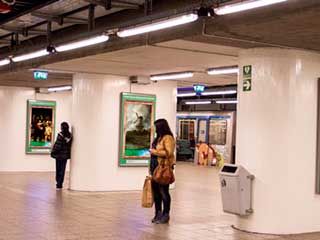Art on Digital Screens
Today everything is being converted into digital formats: ancient manuscripts, archives, and art objects. Museums have to survive, and the only path to survival is through interaction, digital collections and virtual exhibitions.
 |
 |
| Media façade on the Museum for Modern and Contemporary Art in Bolzano (Italy) | Video wall in the Museum of Church History in Salt-Lake-City (USA) |
With its firm foundation in postmodernism philosophy, art transcended physical space. From realistic art-objects art moves towards virtual world. This tendency would remain still-born and relegated to the semi-dark museum interiors if it were not for the explosive growth of digital screen technology that allows to display, transform and multiply images in any quality and any number.
 Urban Screens Project: “Surrey Art Gallery” in Canada
Urban Screens Project: “Surrey Art Gallery” in CanadaGradually, art started to creep out of the museum walls into the city streets, at first using Light Festivals as an excuse. The non-commercial project “Urban Screens” kicked off with the idea of promoting multimedia technologies in urban setting at the beginning of the 21st century. Art festivals on LED screens in Russia were initiated by the “CityVision” advertising agency that used them to demonstrate full potential of LED screens that back in 2006 were still a novelty.
These projects proved that LED screens may be used not only for advertising but for promotion of culture and art among city population. Media façade and projection technology helped to transform whole buildings or featureless walls into fanciful mega-screens.
Today fast growth of digital screen networks (DOOH) turns screens not only into commercial tools for making money on advertising but into informationally-valid social objects. Modern DOOH networks convert public space into art space, informationally and aesthetically saturated.
Modern street-art traditionally included unique posters and graffiti. Today street-art is growing through slide shows demonstrated on DOOH screens, both LCD and LED. Thus, progress in multimedia and LED technology helps change the infrastructure of modern art, its logistics and economics on a global scale. A modern city gradually evolves into a spacious communication environment. It is no longer a place of dense habitation. Modern city is unable to take away the stresses and chaos of dynamic business environment but it can transform urban spaces into something more habitable, less stressful, more aesthetically pleasing and colorful with the help of digital outdoor exhibitions.
Here is a recent example of digital Amsterdam and Rotterdam subway art exhibitions for the famous Rijksmuseum that nicely fit into the completely un-museum-like underground environment.
 |
 |
| Subway digital art gallery in Amsterdam and Rotterdam displaying masterpieces from Rijksmuseum | |
 “Art on the Marquee” Project at the Boston Cyberarts and the Massachusetts Convention Centre
“Art on the Marquee” Project at the Boston Cyberarts and the Massachusetts Convention CentreHere is an interesting example from the USA. It is a long-term “Art on Screens” project under the auspices of the Boston Cyberarts and the Massachusetts Convention Center Authority. The Project offers public media art for display on the new 80-foot-tall multi-screen LED marquee outside the Boston Convention & Exhibition Center in South Boston that can be seen by more than 100 thousand visitors and pedestrians a day. The largest urban screen in New England, this unique digital canvas is one of the first of its kind in the U.S. to integrate art alongside commercial and informational content as part of the MCCA’s longstanding neighborhood art program.
In March 2014 five large US museums agreed to collaborate with the Outdoor Advertising Association of America (OAAA) in conducting a nationwide celebration of US artistic legacy. Previously such events were organized only in iconic locations such as Times Square, Sunset Boulevard and Route 66. Starting on August 4, 2014, and continuing for four weeks, these places and more will be transformed into free open-air galleries for masterworks of American art through Art Everywhere US, the largest outdoor art show ever conceived. Approximately 100 recognized masterworks of American art from the museums' collections will pop up on as many as 50,000 displays nationwide, including static and digital billboards, subway platforms and trains, buses and bus shelters.
 “Art in Transit” on LED screens (Pattison Network)
“Art in Transit” on LED screens (Pattison Network)Something similar but on a significantly smaller scale is regularly conducted by Pattison Onestop Group. The Group organizes thematic art-shows “Art in Transit” on a network of its own digital screens in shopping malls across Canada. For example, in May-June 2014 the Group conducts “Cutting Up Culture” project that showcases many ways in which imagery can manifest both conceptually and stylistically in contemporary collage practice. Combining images sourced from contemporary and historical sources with graphical and design elements, the artists’ show how playful pastiche and nostalgic allure can be created through collage. Their diverse aesthetics and vision bring new meaning to imagery, whether it is iconic, ironic, retrograde or obscure.
 Art Festival on digital screens of the Ocean Outdoor Network
Art Festival on digital screens of the Ocean Outdoor NetworkIn Britain such campaigns are usually conducted on digital screens belonging to Ocean Outdoor Group. Their LED screens frequently carry diverse images in the series of “The Art of Outdoor”, an interactive program that includes direct participation of the public in creative festivals.
These examples are numerous. What is important is that an excellent idea to promote art and culture is now fully supported by operators of digital networks. Art on screens is a new tendency that is here to stay. Today digital OOH screens not only bring to us advertising and information about commercial events but kindle public interest in museums and art exhibitions. Modern digital screens became useful tools that cater for the emotional and intellectual needs of the public.





